Strategies for translating Vietnamese culturespecific items in tourist materials into English
The objectives of this study are to provide fundamental background knowledge for those who
are in favor of translation of culture-specific items in tourist materials and encourage more researchers
to investigate further into related studies as well. To be more specific, it focuses on two sub-projects.
The first one is to examine how professional translators rendered Vietnamese culture-specific items in
tourist materials into English. The second one is to find out which strategies should be used when
translating Vietnamese culture-specific items in tourist materials. The objects of the study are 200
culture-specific items found in tourist materials. Utilizing the framework of translation procedures
suggested by Newmark, the findings show that 3 major strategies (single translation procedures,
couplets and triplets) were used in translating these proper names and common expressions. Among
those three strategies, couplets are preferable when it comes to translating culture-specific items. To be
exact, the strategy Translation using Transference & Synonymy is most used by translators when
rendering Vietnamese destinations into English
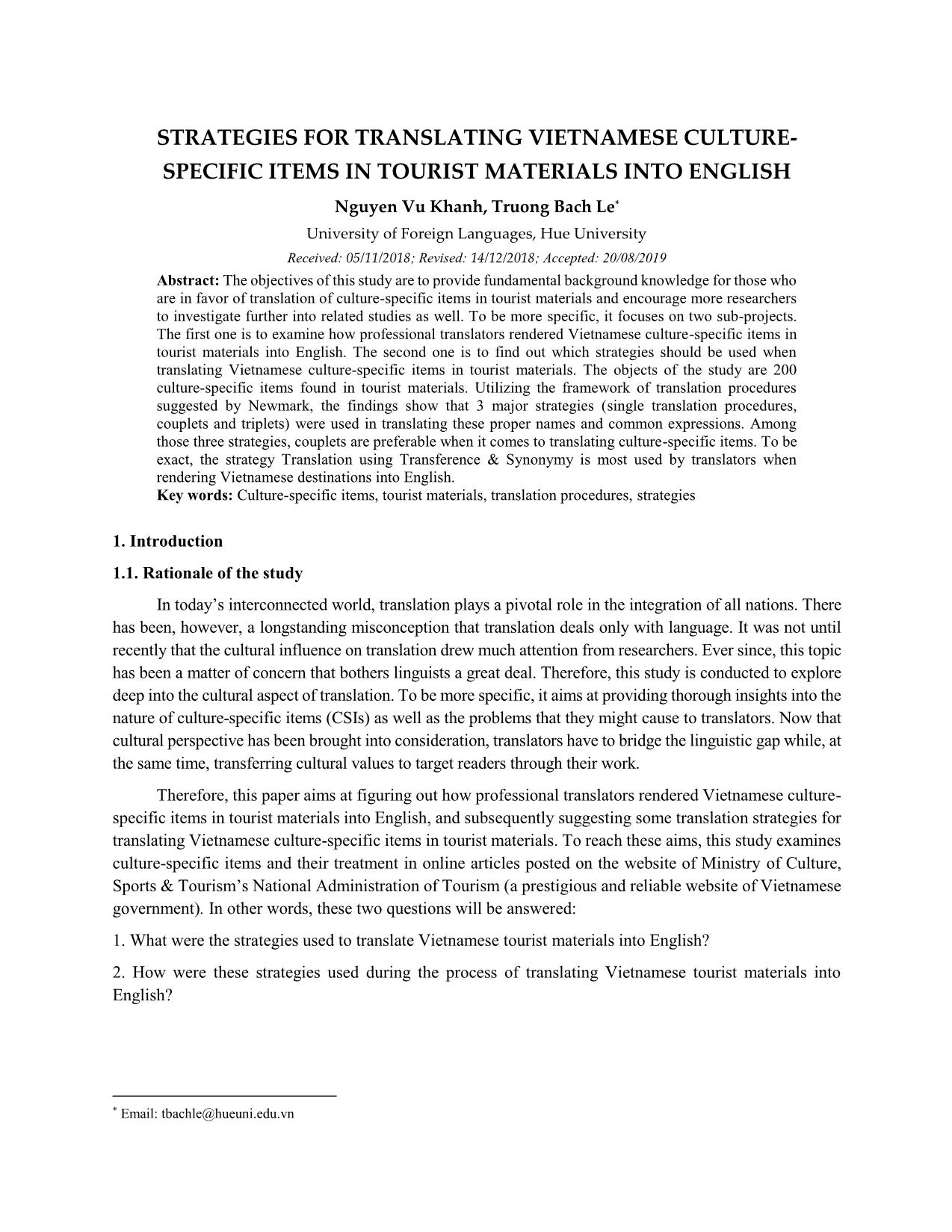
Trang 1
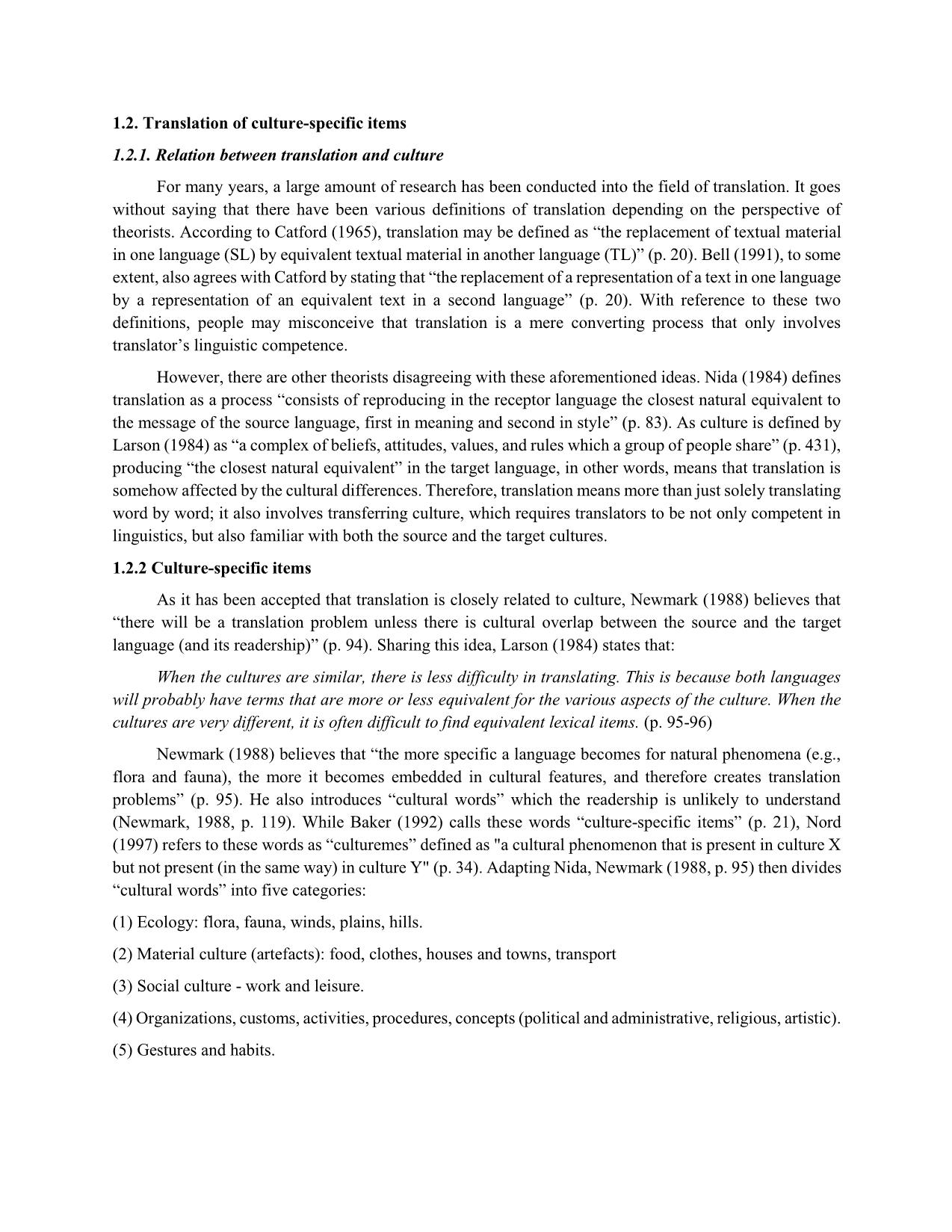
Trang 2
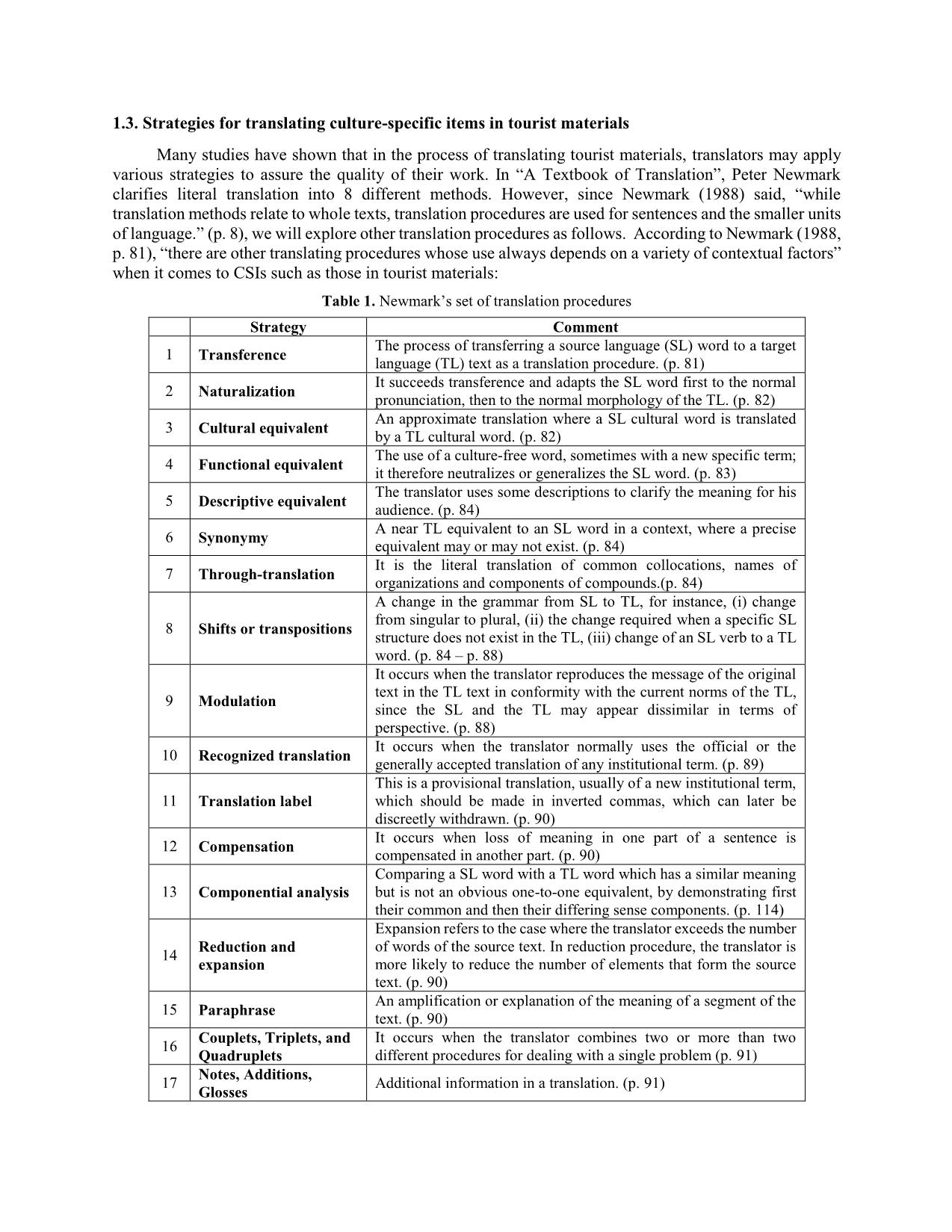
Trang 3
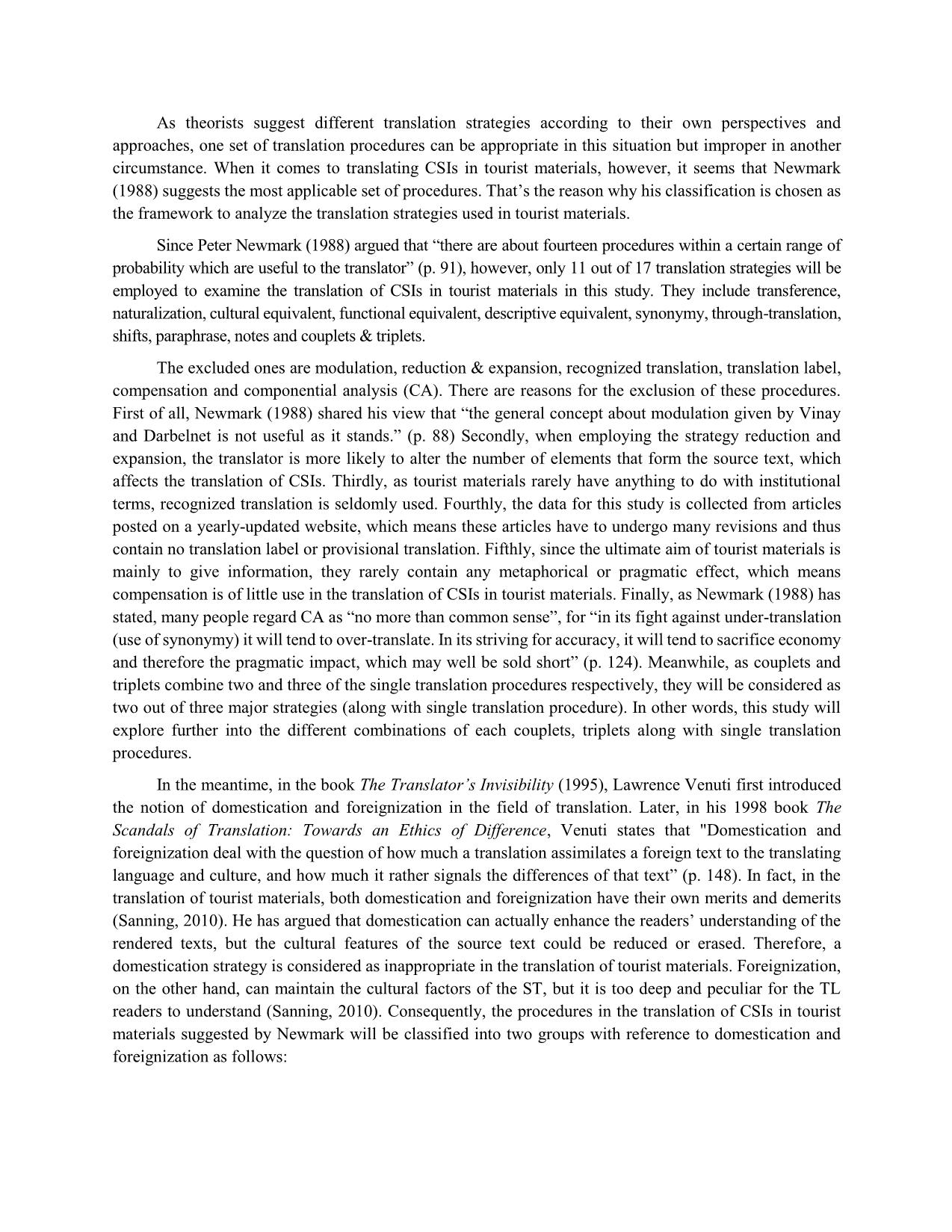
Trang 4
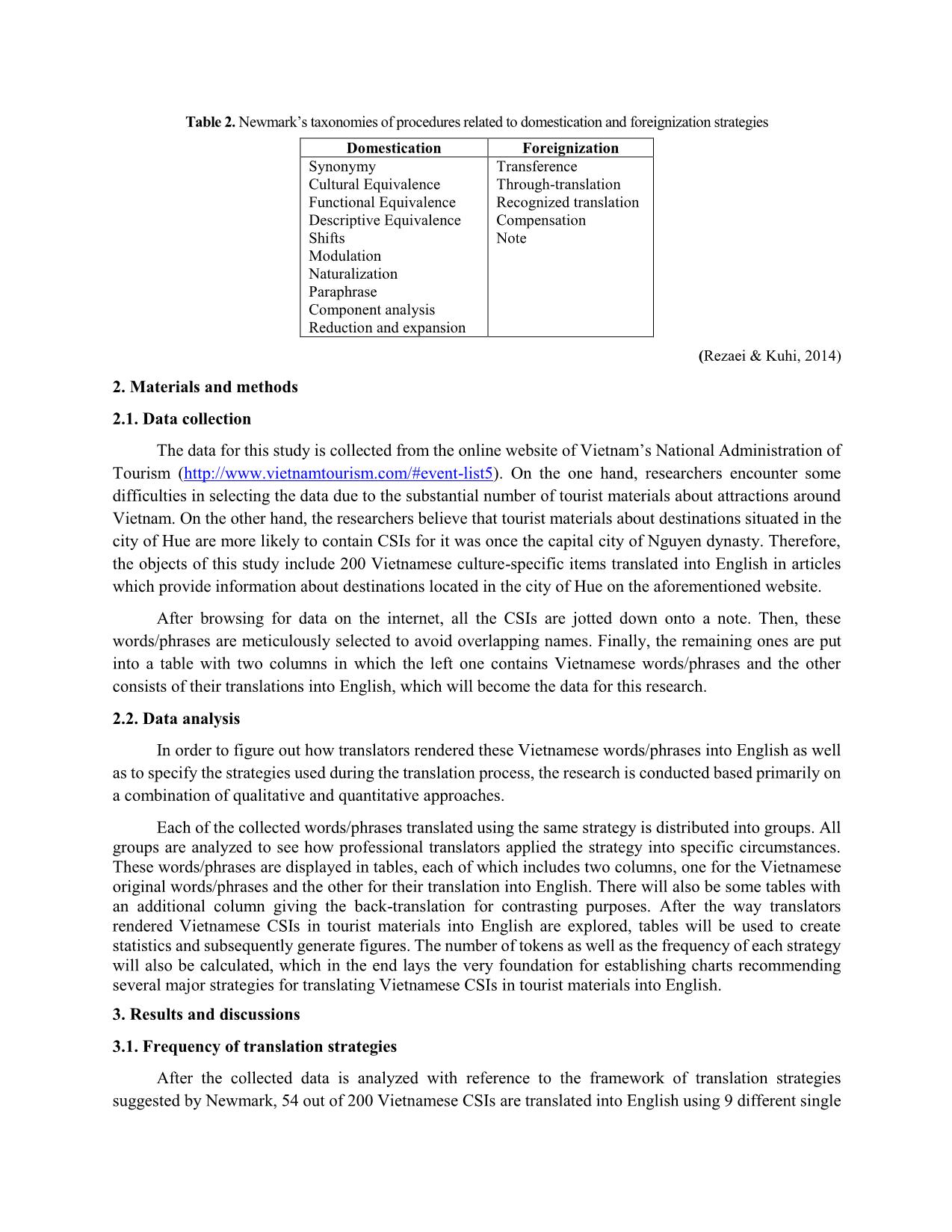
Trang 5
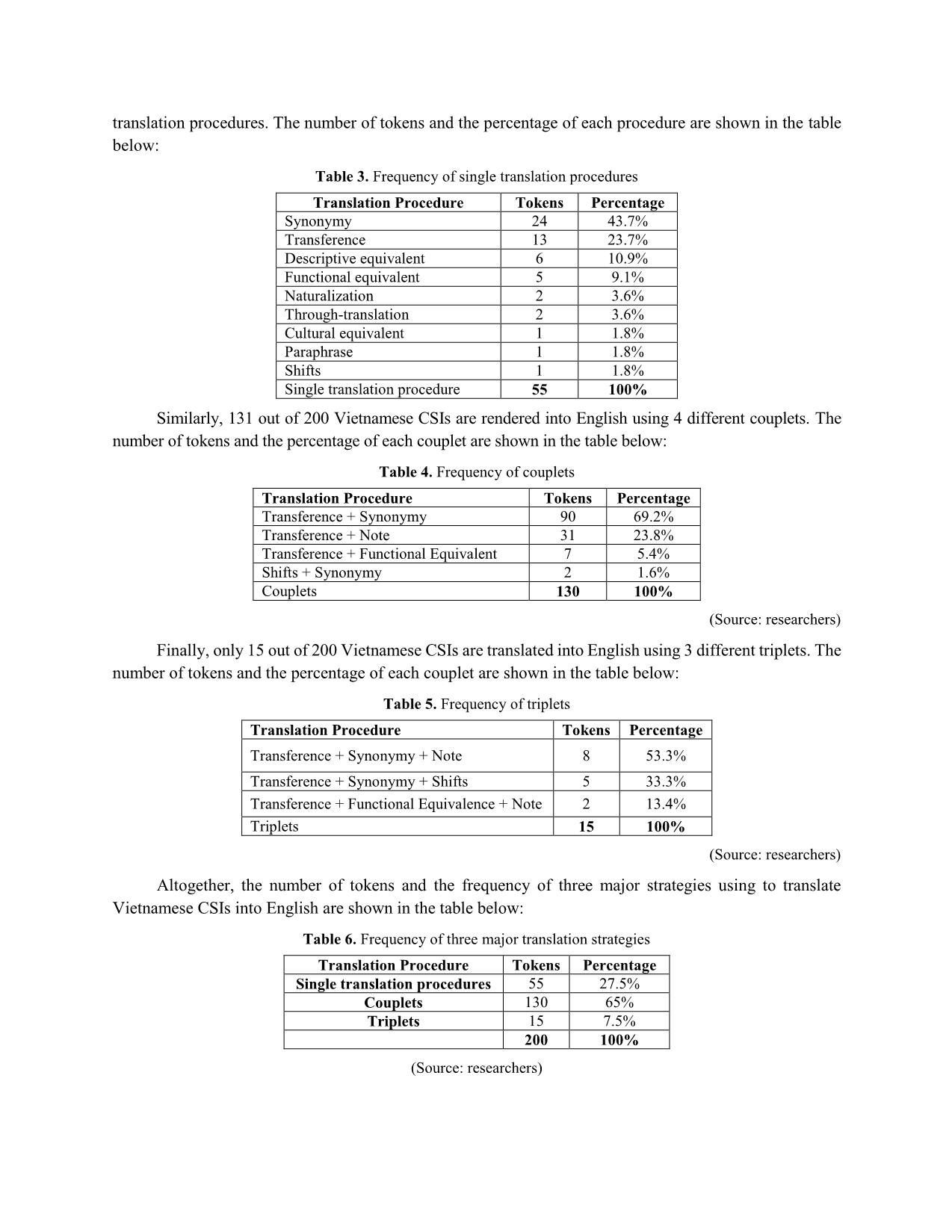
Trang 6
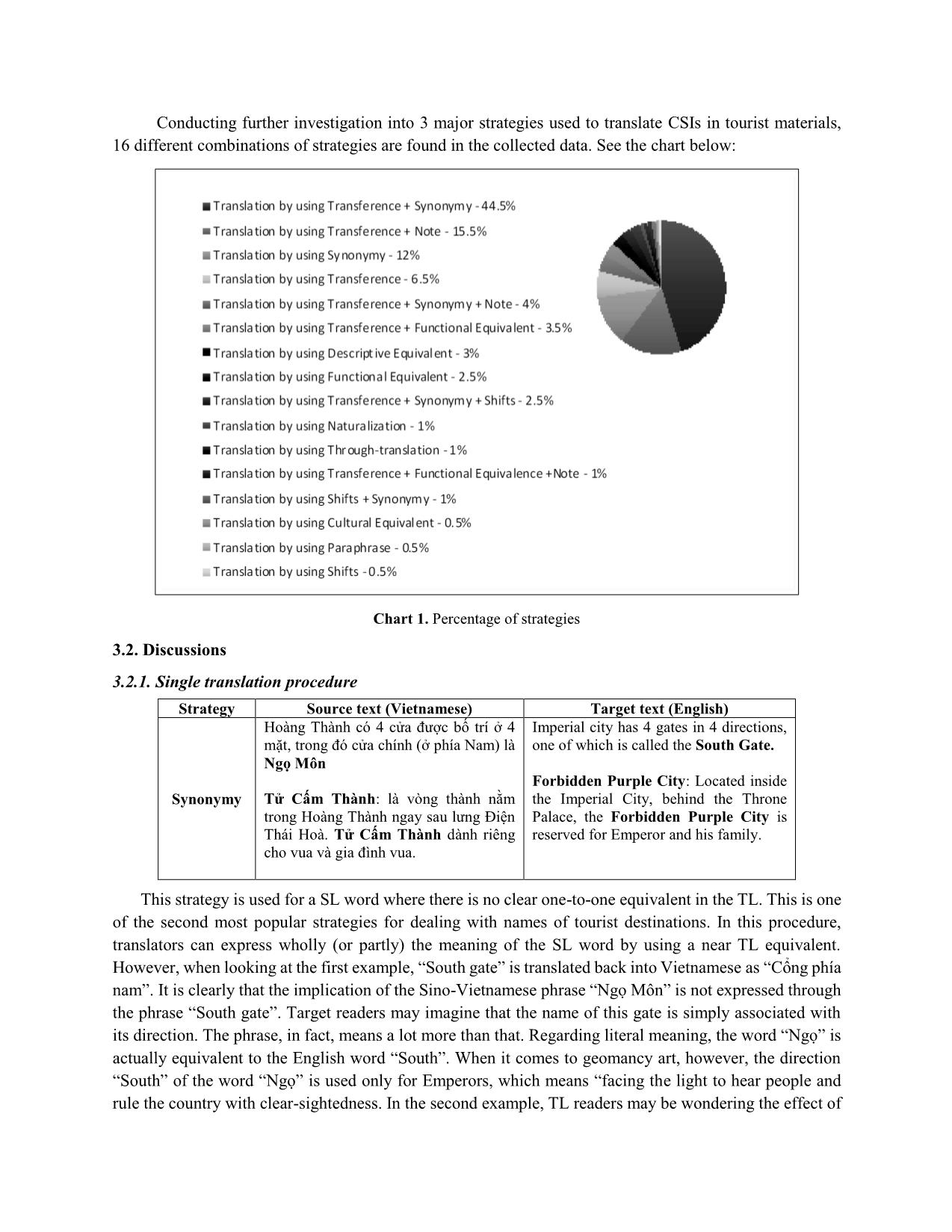
Trang 7

Trang 8
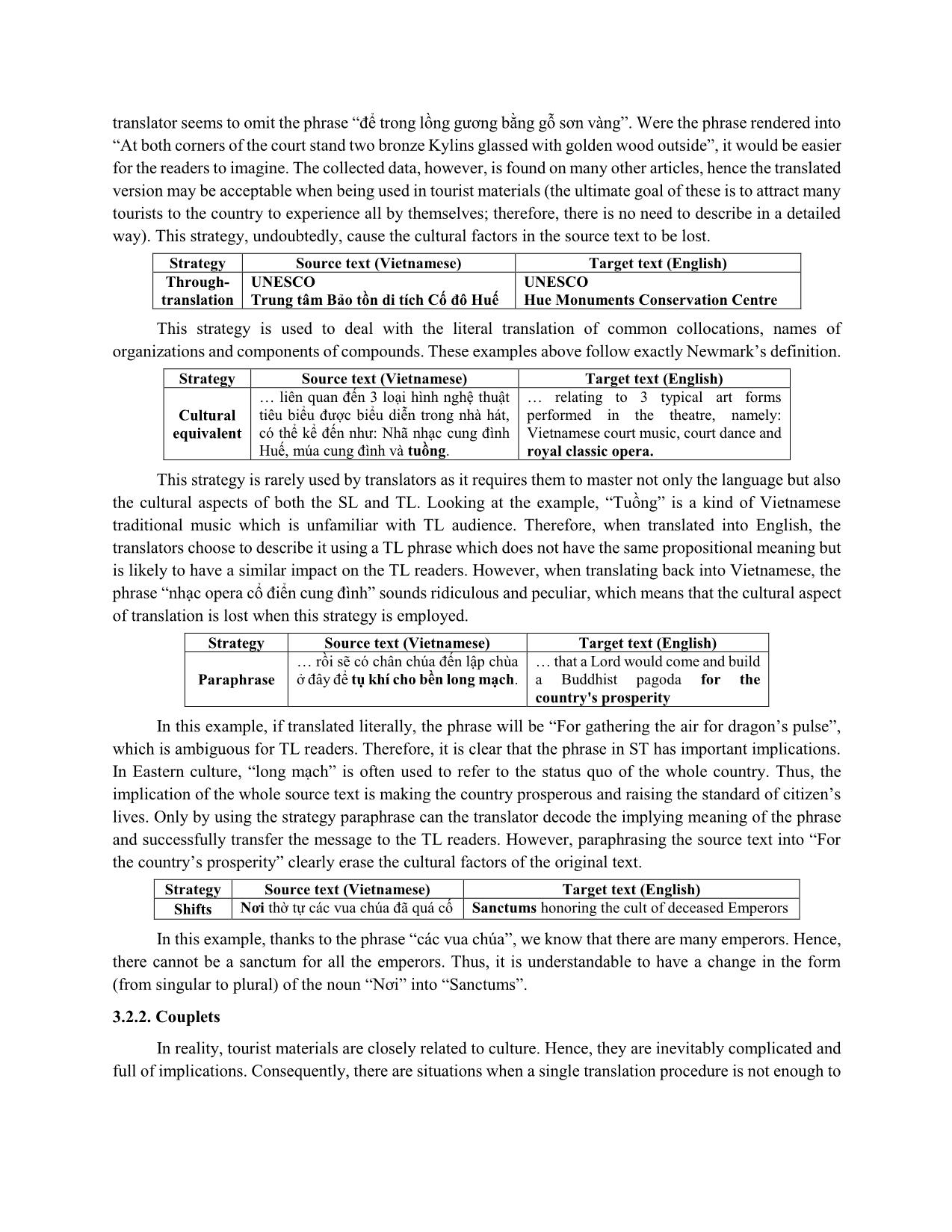
Trang 9

Trang 10
Tải về để xem bản đầy đủ
Tóm tắt nội dung tài liệu: Strategies for translating Vietnamese culturespecific items in tourist materials into English
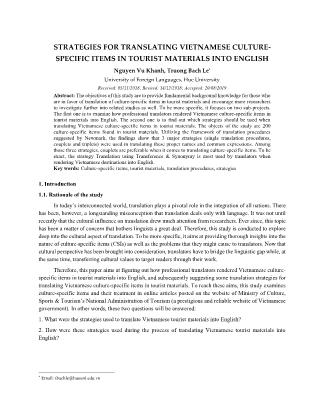
g but is likely to have a similar impact on the TL readers. However, when translating back into Vietnamese, the phrase “nhạc opera cổ điển cung đình” sounds ridiculous and peculiar, which means that the cultural aspect of translation is lost when this strategy is employed. Strategy Source text (Vietnamese) Target text (English) Paraphrase rồi sẽ có chân chúa đến lập chùa ở đây để tụ khí cho bền long mạch. that a Lord would come and build a Buddhist pagoda for the country's prosperity In this example, if translated literally, the phrase will be “For gathering the air for dragon’s pulse”, which is ambiguous for TL readers. Therefore, it is clear that the phrase in ST has important implications. In Eastern culture, “long mạch” is often used to refer to the status quo of the whole country. Thus, the implication of the whole source text is making the country prosperous and raising the standard of citizen’s lives. Only by using the strategy paraphrase can the translator decode the implying meaning of the phrase and successfully transfer the message to the TL readers. However, paraphrasing the source text into “For the country’s prosperity” clearly erase the cultural factors of the original text. Strategy Source text (Vietnamese) Target text (English) Shifts Nơi thờ tự các vua chúa đã quá cố Sanctums honoring the cult of deceased Emperors In this example, thanks to the phrase “các vua chúa”, we know that there are many emperors. Hence, there cannot be a sanctum for all the emperors. Thus, it is understandable to have a change in the form (from singular to plural) of the noun “Nơi” into “Sanctums”. 3.2.2. Couplets In reality, tourist materials are closely related to culture. Hence, they are inevitably complicated and full of implications. Consequently, there are situations when a single translation procedure is not enough to render the SL phrases into TL. Translators thus have to combine two different procedures in order to fulfill the meaning. And according to Newmark, this way of translation is called couplets. Strategy Source text (Vietnamese) Target text (English) Transference combined with Synonymy Together with the Perfume River, Ngu Binh Mount is the second invaluable gift endowed by Nature to Hue. Ngoài ra còn có một cửa phụ thông với Trấn Bình Ðài gọi là Thái Bình Môn. Sau khi Vua Thành Thái bị thực dân Pháp đày sang đảo Réunion, , Gia Hội, Chợ Dinh, Nam Phổ, Bao Vinh, quyện theo mùi thơm của các loài hoa xứ Huế. Cùng với sông Hương, núi Ngự Bình là quà tặng vô giá thứ hai của tạo hoá, quyện vào nhau tạo nên vẻ sơn thuỷ hữu tình của Huế. Besides, the Citadel has an ancillary gate connecting the Tran Binh Bastion called the Peace Gate. After Thanh Thai King was exiled to Reunion Island, , Gia Hoi, Dinh market, Nam Pho, Bao Vinh, mingling with the odors of flowers of Hue This combo is used when translating phrases which include a proper name and a SL word that has an equivalent in TL. In these examples, if the translator uses only transference, the phrases will be rendered as “Ngu Binh” and “Tran Binh” “Dinh” which are ambiguous to TL readers. However, when added the word “mount”, “bastion” and “market”, it turns out that the target text is more understandable even to those who never travel to Vietnam. In the third example, “Island” is undoubtedly the English equivalent of “Đảo”. Also, “Réunion”, a French proper noun, was rendered into “Reunion” using Transference (an omission of the acute accent). Strategy Source text (Vietnamese) Target text (English) Transference combined with Note Thượng Thiện Hổ Quyền Thuong Thien (the kitchen for the Kings' food) Ho Quyen (tiger arena) This combo is used when translators want to supplement information to phrases with a proper name. If a TL audience have never heard about Nguyen dynasty, they cannot get what “Thuong Thien” and “Ho Quyen” mean. Therefore, more information related to the SL culture is added in the bracket to explain the function of the phrases. Strategy Source text (Vietnamese) Target text (English) Transference combined with Functional equivalent Trên nóc nhà trước chắp bằng pháp lam ngũ sắc. on the ridge rests a wine gourd decorated with Phap Lam enamel. This combo is preferred when dealing with phrases including a proper name that needs meaning supplements. The translator can easily transfer “Pháp Lam” into “Phap Lam”. However, as it is obscure to TL readers, “Phap Lam” needs to be clarified by using a culture-free word “enamel”, which crosses out the bewilderment of TL audience. Strategy Source text (Vietnamese) Target text (English) Shifts combined with Synonymy Cửu Đỉnh The Nine Dynastic Urns This combo is used only when there is a change in the grammar from SL to TL happening to the SL phrases which have their equivalents in the TL. In this example, Urn” is the English equivalent of “Đỉnh”. In Vietnamese, the plural form of the noun “Đỉnh” is presented by the word “Cửu” which means nine. However, in English, the plural form of a noun must be presented by the morpheme -s. It is clear that there was a shift in grammar during the translation process. 3.2.3. Triplets Strategy Source text (Vietnamese) Target text (English) Transference combined with Synonymy and Note Hiển Lâm Các được xây dựng phía trước Thế Miếu, Hien Lam Pavilion (Pavilion of the Glorious Coming) is situated in the center of the Dynastic Temple's courtyard, This combo is used when translators want to render SL phrases which include a proper name and a word that has its equivalent in TL while adding extra knowledge. In this example, actually, “Hiển Lâm Các” can also be translated as “Hien Lam Pavilion”. The translator, however, provides the TL readers with more information related to culture of Vietnam by giving the sense of the proper name, which is “Pavilion of the Glorious Coming”. Strategy Source text (Vietnamese) Target text (English) Transference combined with Synonymy and Shifts Lăng Tự Đức Lăng Gia Long Tomb of Tu Duc Tomb of Gia Long This combo is used to when translators want to render SL phrases which include a proper name and a word that has its equivalent in TL while witnessing a change in the grammar from SL to TL happening to the SL phrases. In these aforementioned examples, “tomb”, the English equivalent of “Lăng”, is combined with the proper names, namely “Tu Duc” and “Gia Long”. Also, it is obvious that an SL grammatical structure does not exist in the TL (there is no such phrase as “Tomb Tu Duc”. The possible options are “Tomb of Tu Duc”/ “Tu Duc’s tomb” and “Tomb of Gia Long”/ “Gia Long’s tomb”. Either way, there is undoubtedly a change in the grammar happening during the translation process. Strategy Source text (Vietnamese) Target text (English) Transference combined with Functional equivalent and Note Châu Ô và Châu Lý the areas of O and Ly (now Quang Tri and Thua Thien-Hue provinces) This combination is used when the translators want to generalize the ST with a proper name as well as giving further details. This is a clear example. “Châu is a Vietnamese administration term. Therefore, in order to generalize, the translator renders it into “the areas”. Moreover, since “Châu Ô” and “Châu Lý” no longer exists, the translator gives additional information about these areas to avoid making confusion to TL readers. 4. Conclusions and recommendation 4.1. Conclusion The findings of this study allow these following conclusions to be withdrawn: Firstly, nearly all of the strategies proposed by Newmark (11 out of 17) are employed when translating CSIs in tourist materials. A single method can be applied in one circumstance, but in some cases, two strategies (Couplets) or three strategies (Triplets) are combined during the translation process. Based on the findings, most of the CSIs found in the collected data are proper names. They include names of people, objects and destinations, and these names are usually kept intact during the translation process (Transference). However, when it comes to proper names that have an implying meaning, translators are inclined to employ strategies that can decode the message behind that name (Synonymy) when translating. Secondly, by using the suggested translation strategies of Newmark, it is found that 9 Single translation procedures, 4 Couplets and 3 Triplets are employed to render CSIs in tourist materials. Even though the number of single translation procedures is highest, couplets are most preferred when it comes to translate CSIs. (with 130 tokens compared to 55 and just 15 for single translation procedures and triplets respectively). The strategy “Translation using Transference + Synonymy” is most used with nearly haft of the proportion (45%), followed by “Translation using Transference + Note” (15.5%), Synonymy (12%), and Transference (6.5%). This proves Newmark’s statement in his book “A textbook of translation” (1988): When the translator has to decide whether or not to transfer a word unfamiliar in the target language, which in principle should be a SL cultural word whose referent is peculiar to the SL culture, he usually complements it with a second translation procedure - the two procedures in harness are referred to as a ‘couplet’() Needless to say, in principle, the names of SL objects, inventions, devices, processes to be imported into the TL community should be creatively, preferably 'authoritatively', translated. (p. 81) Thirdly, at the other end, the strategies “Translation using Paraphrase”, “Translation Cultural equivalent” and “Translation using Shifts” share the bottom rank with the frequency of only 0.5%. This also conforms to the reluctance of Newmark to list “Paraphrase” as a translation procedure, since the word is often used to describe free translation. (1988, p. 91). In addition, since “the main purpose of “Cultural Equivalent” is to support or supplement another translation procedure in a couplet” (Newmark, 1988, p. 83), there is no surprise when this procedure is less preferred. Finally, Newmark (1988) commented that “the word order is changed unnecessarily, and it is sometimes more appropriate to translate with a lexical synonym, retain the word order and forgo the shifts (transposition) in order to preserve the stress.” (p. 88), which explains for translators’ reluctance to employ “shifts” during the translation process. Finally, according to the frequency of occurrence of translation procedures, more target texts are translated using foreignization strategies than domestication ones. It is probable that during the translation of CSIs, translators incline to sacrifice the readability of the target text for retaining cultural factors of the source text. 4.2. Recommendation Newmark (1988) said that translation involves rendering the content of a source text into another language in a way that TL readers feel and respond in the same way as SL audience does. Whereas, translating a source text into a target text without altering the particular messages is an exceptionally troublesome undertaking. Hence, it is undeniable that profound research into translation strategies plays a pivotal role in assuring the quality of the translation. During translation courses, students as well as teachers should pay more attention to cross-cultural communication which provides useful information about how cultural factors affect the translation process. In addition, they should be careful when choosing the translation strategies since these strategies are crucial in the translation process. Both beginner and expert translators should build up their abilities of translating CSIs. In the meantime, they should also learn how to pick words and expressions as well as broaden their English vocabulary so as to make proper translations. There are still many issues related to the field of translation of Vietnamese tourist destinations in tourist materials that need to be explored further: - Further research should focus on other kinds of tourist materials (brochures, magazines, travel guide, etc) - Further research should also focus on cultural characteristics of tourist materials in Vietnam. - Further research should focus on cultural aspects and their impacts on tourist materials’ translation process. References Website: Ministry of culture, sports & tourism’s national administration of tourism. Retrieved from: Baker, M. (1992). In other words: A coursebook on translation. London: Routledge. Bell, R.T. (1991). Translation and translating: Theory and practice. London: Longman. Catford, J.C. (1965). A linguistic theory of translation: An essay on applied linguistics. London: Oxford University Press. Larson, M.L. (1984). Meaning-based translation: A guide to cross-language equivalence. Lanham and New York: University Press of America, Inc. Newmark, P. (1988). A textbook of translation. London: Prentice Hall. Nida, E. (1984). On translation. Beijing: Translation Publishing Corp. Nord, C. (1997). Translating as a purposeful activity: Functionalist approaches explained. Manchester: St. Jerome. Rezaei, M., & Kuhi, D. (2014). Strategies emplyed in translation of tourist guidebooks culture-specific items from Persian into English. Theory and Practice in Language Studies, 4(4), 750-757. Doi: 10.4304/tpls.4.4.750-757. Sanning, H. (2010). Lost and found in translating tourist texts: Domesticating, foreignising or neutralising approach. Specialised Translation, 13(1), 124-137. Venuti, L. (1995). The translator’s invisibility. London: Routledge. Venuti, L. (1998). The scandals of translation: Towards an ethics of difference. London: Routledge. NGHIÊN CỨU VỀ CÁC CHIẾN LƯỢC DỊCH NHỮNG TỪ NGỮ VĂN HÓA TIẾNG VIỆT TRONG TÀI LIỆU DU LỊCH SANG TIẾNG ANH Tóm tắt: Bài báo này chú trọng vào hai vấn đề: đầu tiên là xem xét cách những chuyên gia dịch những từ ngữ văn hóa tiếng Việt trong các tài liệu du lịch sang tiếng Anh, thứ hai là tìm ra những chiến lược sử dụng cho quá trình dịch thuật này. Đối tượng nghiên cứu là 200 từ ngữ văn hóa (culture-specific items), bao gồm các tên riêng (proper names) và diễn đạt thông thường (common expressions) trong tài liệu du lịch trên website ( vietnamtourism.com/en/index.php/tourism/cat/05). Khi sử dụng hệ thống phân loại quy trình dịch do Newmark đề xuất, kết quả cho thấy có 3 chiến lược chính đã được sử dụng (bao gồm dịch đơn, bộ đôi và bộ ba). Trong số đó, chiến lược bộ đôi được ưu tiên lựa chọn. Cụ thể, bộ đôi Chuyển dịch (Transference) và Từ đồng nghĩa (Synonymy) được sử dụng nhiều nhất. Từ khóa: Từ ngữ văn hóa, tài liệu du lịch, quy trình dịch, chiến lược dịch
File đính kèm:
 strategies_for_translating_vietnamese_culturespecific_items.pdf
strategies_for_translating_vietnamese_culturespecific_items.pdf

